This Sourdough Japanese Salt Bread Shio Pan combines a milk roux (tangzhong) and sweet levain with 25% whole grain einkorn flour. Its soft, fluffy consistency and distinctly light texture make it a popular choice for breakfast or as a snack.
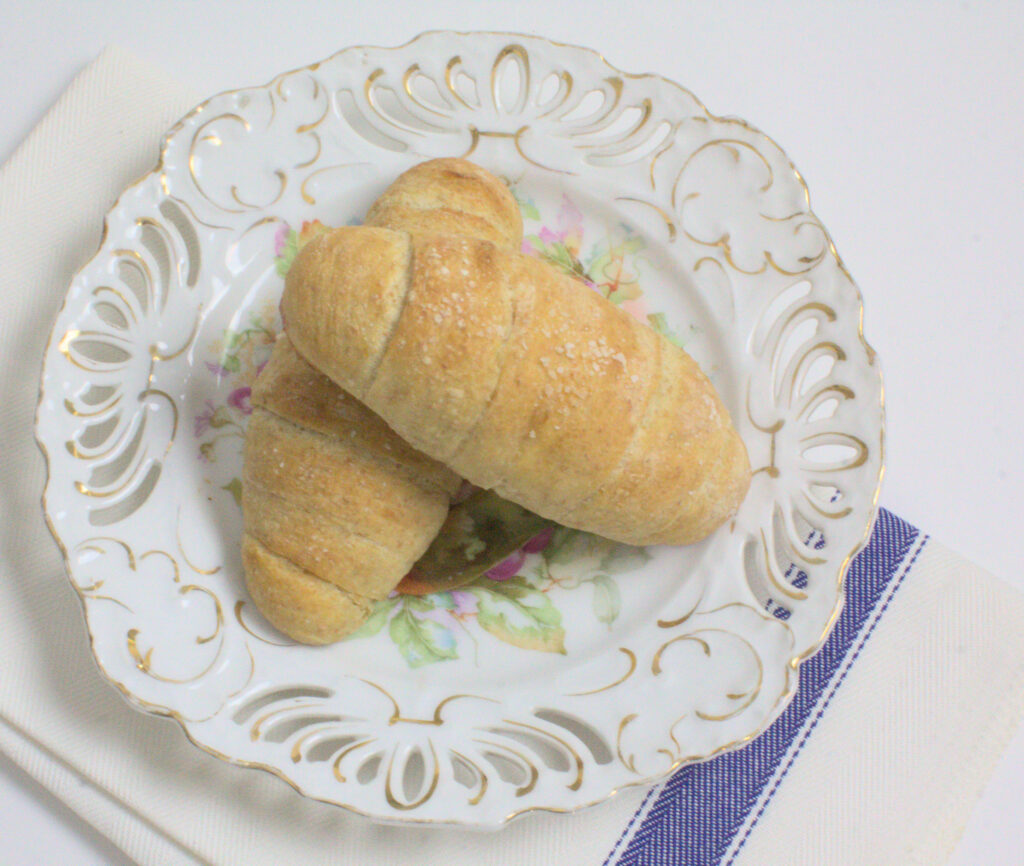
Japanese Salt Bread Shio Pan is the bread of the month for the Bread Baking Babes. Karen, of Karen’s Kitchen Stories, our host kitchen this month, decided to recreate these rolls after enjoying them at a Japanese bakery in Anaheim.
When describing this Japanese Salt Bread, Karen said, “I know they look a bit like crescent rolls, but they are different, in that, stuffed right in the middle is a long piece of butter that melts onto the baking sheet and kind of “fries” and crisps the bottom of the roll. Plus, the butter melts onto the baking sheet and becomes browned, adding even more flavor. It’s divine! In addition, the shaping method involves stretching the dough into a long thin triangle that you roll up into a crescent.”
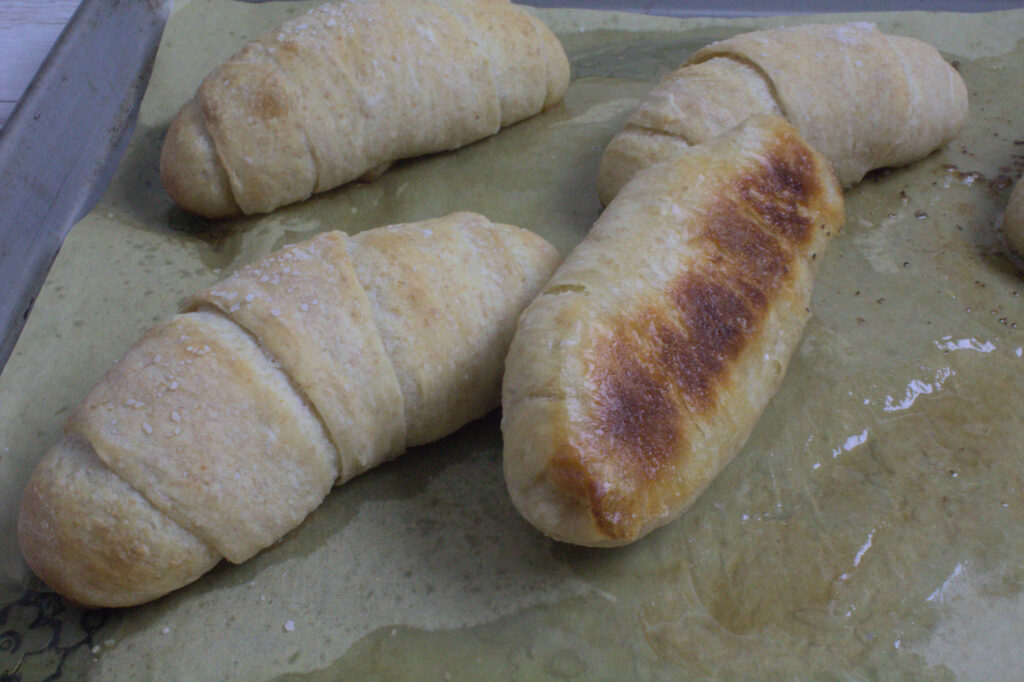
I used Karen’s adapted recipe as a starting point. She adapted her recipe mostly from Vanillyn Bakery, but with adaptations from Food 52 and others.
As I typically do, I included some whole grain flour, in this case, einkorn. To retain the soft and fluffy texture, I incorporated a tangzhong to soften the dough and used a sweet levain to provide leavening. Due to the amount of butter in the dough, I spiked the dough with a bit of dried yeast to give it a bit more lift.
What is Japanese Salt Bread?
Shio Pan, or Japanese Salt Bread, is a delightful bakery staple from Japan known for its simplicity and savory flavor.
This bread boasts a light, fluffy texture inside, with a slightly crisp outer crust delicately sprinkled with sea salt. Its mild taste makes it a perfect canvas for spreads like butter, jam, or as a base for sandwiches.
The charm of Shio Pan lies in its elegant balance of flavors – not too salty, not too bland – making it a delightful treat for those who appreciate the subtlety in taste and texture.

Incorporating a Milk Roux (Tangzhong)
Tangzhong, also known as a water roux or milk bread, is a method used in breadmaking to improve the softness and longevity of the bread by pre-cooking a portion of the flour and liquid (water or milk) from the recipe. It’s a technique popularized by the Japanese but rooted in Asian baking traditions.
Incorporating a tangzhong into Shio Pan dough offers significant benefits. The cooked mixture of milk and flour, gelatinizes the starches in the flour, allowing it to absorb more liquid. This results in dough that is more hydrated without being too wet or sticky. The increased hydration leads to bread that is exceptionally soft, fluffy, and tender. Additionally, tangzhong extends the bread’s shelf life, keeping it moist and fresh for a longer duration. This method also improves the bread’s structural integrity, ensuring it holds its shape well during baking and yielding a finer, smoother crumb.
The general rule of thumb for making tangzhong is to use about 5-10% of the total weight of the flour in the recipe. This pre-cooked mixture is typically made at a ratio of 1 part flour to 5 parts water by weight.
For this recipe, I went with a ratio of 7 percent of the total flour which equates to 15 grams (7% of 210 grams). I used all-purpose flour (King Arthur Baking AP flour which has a higher protein level) rather than the bread flour called for in the adapted recipe.

Using a Sweet Levain
Using a sweet levain in Shio Pan dough instead of a regular levain brings several benefits. It imparts a subtle sweetness that complements the light saltiness of the bread, enhancing its overall flavor profile.
This type of levain also contributes to a more tender crumb, as the sugars in the sweet levain help to retain moisture, resulting in a softer, fluffier texture. Additionally, the fermentation process with a sweet levain can improve the dough’s extensibility, making it easier to handle and shape. Finally, the sweet levain can also extend the bread’s shelf life by naturally preserving its freshness and softness for a longer period.
I used slightly less than 20 percent of sweet levain in this recipe (20% x 210 grams of flour = 42 grams). I went with 40 grams to make the calculations easy. I used the method from my Light Wheat Sourdough Wool Roll Bread.
For the final dough, I subtracted the amount of flour from the tangzhong and the levain to keep the proportions correct (210g total flour -15g – 40g = 155 grams). I only used milk in the final dough and kept the hydration around 60 percent.
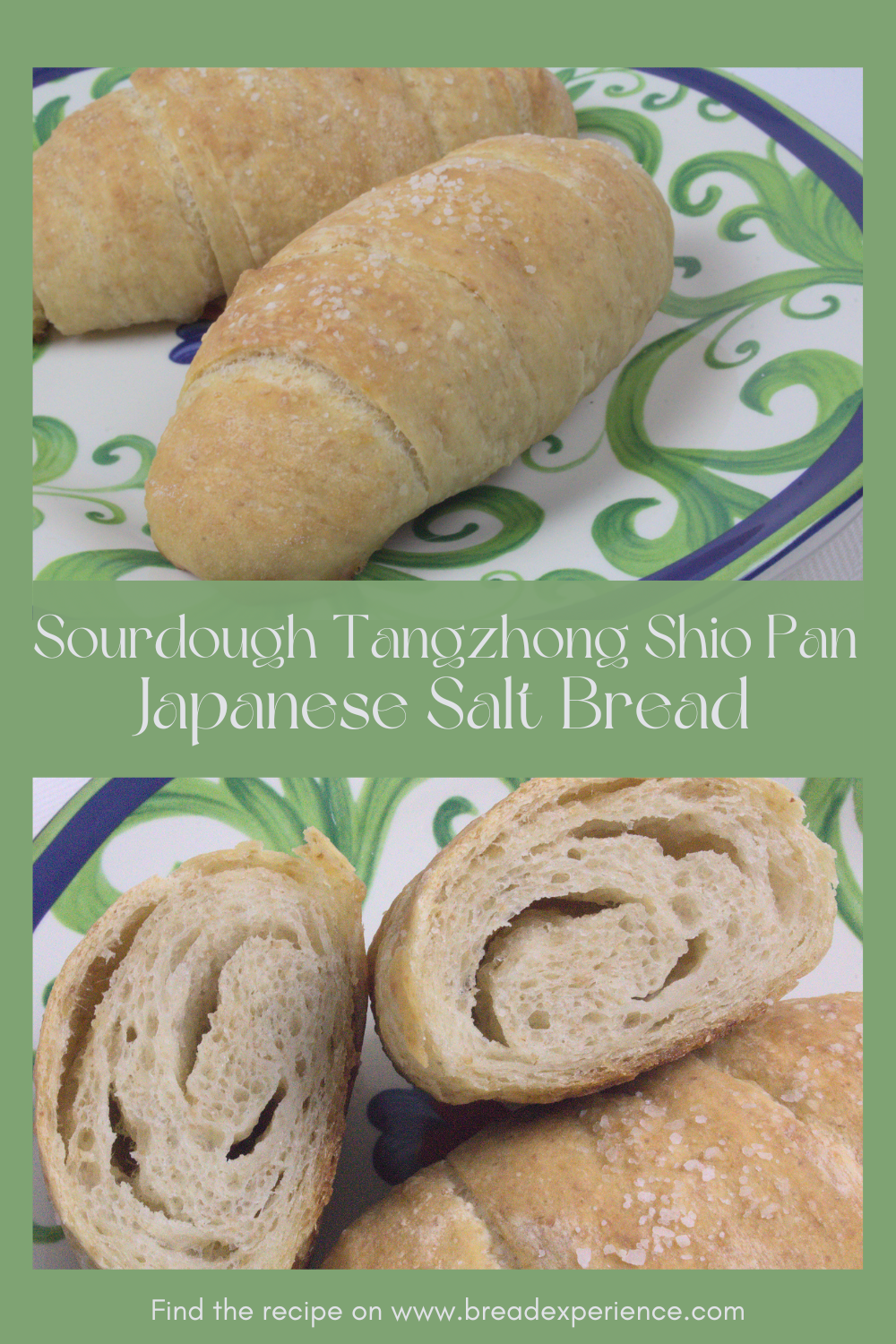
Resources, gathered by Karen, for making different types of Shio Pan Japanese Salt Bread
- Tara’s Multicultural Table
- Vanillyn Bakery
- Food 52
- Cooking in Chinglish (includes a preferment)
- What to Cook Today (sourdough version)
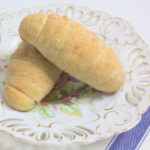
Shio Pan Japanese Salt Bread
- Yield: 6 Crescents 1x
Description
This Shio Pan, a Japanese Salt Bread, combines a milk roux (tangzhong) and sweet levain with 25% whole grain einkorn flour. Its soft, fluffy consistency and distinctly light texture make it a popular choice for breakfast or as a snack.
Ingredients
Sweet Levain:
- 40 grams (~1/4 cup) whole wheat flour (I used einkorn)
- 40 grams (2 3/4 Tbsp.) water
- 20 grams (~1 heaping Tbsp.) sourdough starter
- 2 grams (1/2 tsp.) sugar
Tangzhong:
- 15 grams (~1 1/2 Tbsp. + 1/2 tsp.) whole wheat flour (I used einkorn)
- 75 grams (5 Tbsp. / scant 1/3 cup) milk, dairy or non-dairy
Dough:
- 155 grams (1 rounded cup) all-purpose flour
- 8 grams (2 tsp.) sugar
- 4.3 grams (3/4 tsp.) fine sea salt
- 1.6 grams (1/2 tsp.) instant yeast
- 90 grams (6 Tbsp.) cold milk, divided
- 7 grams (~1 1/2 tsp.) softened butter
- 15 grams (~1 rounded Tbsp.) butter, melted, for brushing
- 60 grams (~4 Tbsp.) butter, cut into six 10 gram strips
- Flaked sea salt or coarse Kosher salt for topping
Instructions
Make the Sweet Levain:
- In a small bowl, mix the sourdough starter, warm milk, flour and sugar until combined. Cover the bowl and let the mixture rise at warm room temperature until doubled in size, about 8-10 hours, depending on the temperature in your kitchen.
Make the Tangzhong:
- In a small saucepan, whisk together 15 grams of whole wheat flour and 75 grams of milk until no lumps remain.
- Bring the mixture to a simmer over medium-low heat and continue whisking until the mixture has thickened. To determine when it is ready, run your whisk along the bottom of the pan. It should leave an indentation. This should take 5-10 minutes.
- Pour the mixture into a small bowl, cover with plastic wrap, and allow to cool at room temperature.
Make the Dough:
- In a large mixing bowl, combine the levain, tangzhong, and 75 grams of cold milk. Using a wooden spoon or Danish dough whisk, mix until it forms a shaggy dough. Add in additional milk, 1 tablespoon at a time until there are no dry bits of flour. Cover and let rest (autolyse) for 30 minutes.
- Sprinkle the salt and yeast over the dough. Mix thoroughly. Cover, let the dough rest for 30 minutes.
- Mix in 7 grams of softened butter a little at a time using your fingers.
- Cover, and let it proof for 1 ½ – 2 hours. Perform a 3 folds, at 30 minute intervals, during the first 1 – 1 ½ hours. To fold the dough, gently stretch and fold the edges into the center. After the 3rd fold, cover, and let the dough rest for 30 minutes.
- Turn the dough out onto a floured work surface. Roll or press it into a ½ inch thick round disk.
- Using a sharp knife or bench scraper, cut the disk into 6 equal wedges.
- Roll each wedge into a cone. Pinch the seam, and let each piece rest, covered, for 10 minutes.
- Using floured fingers, press each cone into a triangle. Using a rolling pin, roll each piece into a very long, thin triangle. Lightly brush each triangle with melted butter. Place one of the 10 gram butter sticks on the wide end and roll the dough up, stretching as you go, to form into a crescent shape.
- Place the crescent on a parchment-lined rimmed baking sheet. Repeat the shaping process with the remaining dough pieces. Cover and let the crescents rise in a warm place until puffy, about 45 minutes to an hour. It may take longer, depending on the temperature of your kitchen.
- Preheat the oven to 400 degrees F. with a rack on the middle shelf.
- When the Shio Pan rolls are ready to bake, spray or brush the rolls with water. Sprinkle each roll with a pinch or so of sea salt.
- Bake for 20 – 25 minutes, rotating the pan a couple of times for even baking. The Shio Pan should be lightly golden on top and crispy and brown on the bottom.
- Transfer to a wire rack to cool slightly before enjoying.
- These are best warm from the oven or within two hours. You can rewarm leftovers the same day to refresh them. Wrap and freeze additional leftovers for reheating in the oven the next day.
Notes
Use a rimmed baking sheet to keep the melted butter in the pan.
- Category: Buttery Salt Bread
- Method: Tanghzhong
- Cuisine: Japanese Rolls
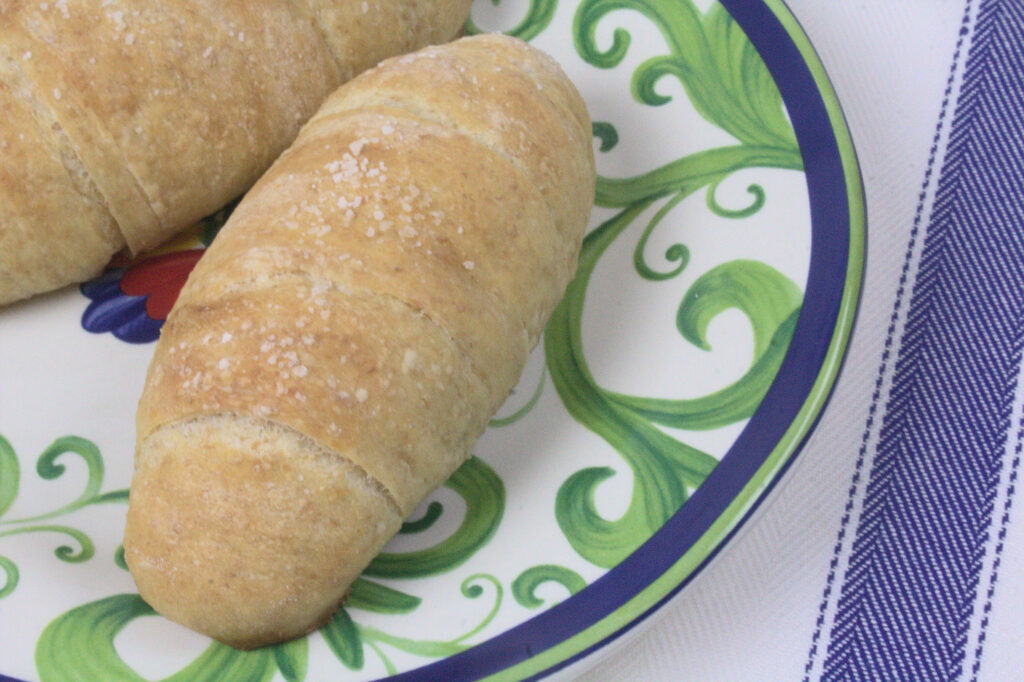
Who are the Bread Baking Babes?
We are a group of bread bakers who get together every month and bake bread! We would love for you to bake Japanese Salt Bread Shio Pan and share how it turned out and what you thought! Karen, of Karen’s Kitchen Stories, is the host kitchen this month.
Check out our Facebook group to see the participants’ baking results during that time. If you would like to post your results with a Buddy badge on a blog, let us know in the comments or on the Facebook page.
The Bread Baking Babes
Karen’s Kitchen Stories – Karen (host kitchen)
A Messy Kitchen – Kelly
Judy’s Gross Eats – Judy
Bread Experience – Cathy
blog from OUR kitchen– Elizabeth
Feeding My Enthusiasms – Elle
My Diverse Kitchen – Aparna
Thyme for Cooking – Katie (roundup)

Happy Baking!
Cathy
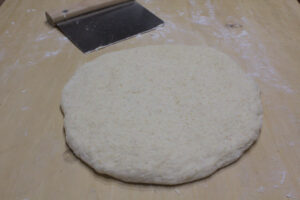

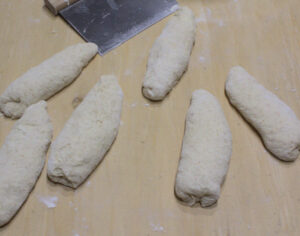
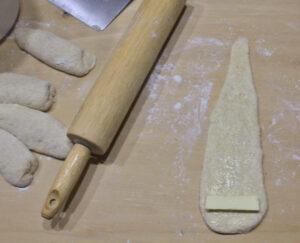

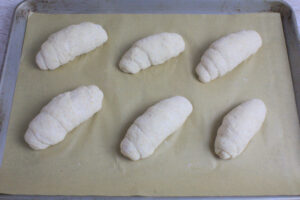
Karen's Kitchen Stories says
I love the look of your rolls and the crispy bottom! Thank you so much for baking along!
Cathy says
Thank you for choosing Shio Pan, Karen! This was a delicious bake!
Kelly says
Beautiful crumb! And I’ll bet the einkorn added wonderful flavor with the butter.
Cathy says
Thanks Kelly! The einkorn did provide a lovely flavor.
Katie Zeller says
I didn’t know abut a milk roux – very interesting! And your rolls look fantastic!
Cathy says
Thanks Katie! The milk roux is interesting. I plan to use it a lot.
Elizabeth says
I’m so glad you made a sourdough version, Cathy! I’m doubly glad that you described your reason for using a sweet levain that “contributes to a more tender crumb, as the sugars in the sweet levain help to retain moisture, resulting in a softer, fluffier texture”. I think I might need to try that to get our regular sourdough bread to have a softer fluffier crumb. The tangzhong method is a really good idea too.
Cathy says
This was a fun experiment! The sweet levain really helped. I don’t know why I haven’t used it more often. I plan to change that. I also plan to include a tangzhong in more breads, especially ones with whole wheat.
Elizabeth says
Do you think it would work just as well if you used honey instead of sugar in the levain?
Cathy says
I haven’t tried using honey instead of sugar in the sweet levain, but it’s worth testing.
Elizabeth says
I’ll try it out with the levain for tomorrow’s bread and report back.
Cathy says
Sounds like a plan!
Elizabeth says
Well. Very interesting. Honey does work. But it makes the levain, as well as the dough very active. Very. I was vigilant during the folding and proofing time – significantly shorter than usual – but I’m afraid that I let it overproof just a little after the bread was shaped. Having said that, the bread (standard Tartine loaf : 100 grams whole wheat 100% hydration levain (including 2 grams honey), 500 grams unbleached all-purpose, 20 grams wheat germ, 375 grams lukewarm water, 10 grams salt) was beautiful! The crumb was softer than usual and there was wonderful crackling when it came out of the oven. And. There were magic words from the resident critic: “I think this is lighter than usual.”
You are onto something good with this sweet levain, Cathy. Thank you for the idea!!
Cathy says
Thanks for checking back in with the results of the test of the sweet levain. That is very cool! I’m so glad your resident critic approves or at least somewhat.
Aparna says
That crumb looks especially beautiful. As I mentioned on FB, I like the idea of using a sweet levain. I’m going to try that next time.
Cathy says
Thank you Aparna! I used a sweet levain in a different bread recently, and as Elizabeth mentioned, adding a bit of sugar (or honey) speeds up the fermentation activity so the dough can get overproofed very quickly. Just keep that in mind.